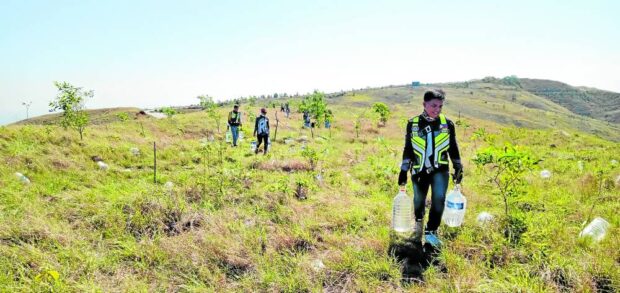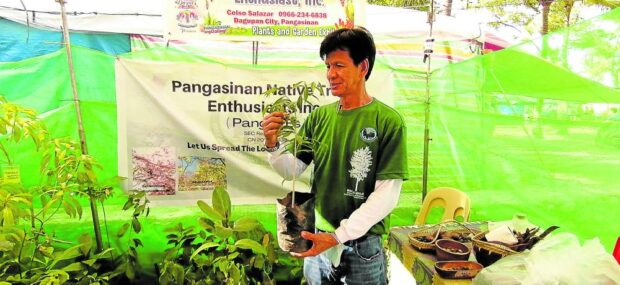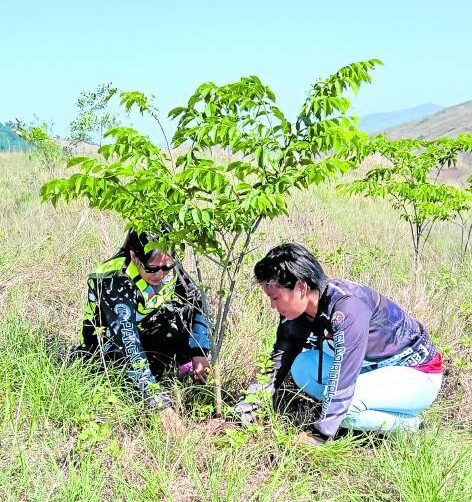In Pangasinan, volunteers spread love for native trees

SUSTAINING LIFE | Members of the Eagles Club lug water jugs to the upland arboretum along Daang Kalikasan in Mangatarem, Pangasinan, during the group’s recent watering activity. Volunteers puncture holes in the jugs and put them beside the seedlings to keep the soil wet before their next visit. (Photo by YOLANDA SOTELO / Inquirer Northern Luzon)
MANGATAREM, Pangasinan, Philippines — A tree blooming with dainty pink and white flowers greeted a group of volunteers on their way to an upland arboretum of native trees along Daang Kalikasan in this agricultural town on April 29.
The flowering tree turned out to be patalsik pula (Decaspermum blancoi), one of the rarest native trees in the country.
“It’s not on the list of the native trees we knew and planted,” Edward Muego, 52, a member of Pangasinan Native Tree Enthusiasts (PNTE), told the Inquirer.
This group of native tree lovers and volunteers trekked to the mountain to water around 3,000 tree seedlings and saplings that were planted in the past two years.
Around 2 hectares of the arboretum (botanical garden devoted to trees) have been planted with different native tree seedlings, said Celso Salazar, PNTE president and a retired official of the Department of Environment and Natural Resources (DENR).
Article continues after this advertisementThe area may seem small, but it is proof that the love for native trees is germinating in Pangasinan, sown by a group of six people with different backgrounds sometime during the pandemic, Salazar said.
Article continues after this advertisementAmong themselves, they talk about native trees whose names sound bizarre to most people — balitbitan, kalumpit, siar, kamagong, yakal-saplungan, tibig, hauli siar, supa, kalumpang, igyo, paguringon, balai lamok, tindalo, is-is and kusibeng.

RAISING AWARENESS | Celso Salazar, president of the Pangasinan Native Tree Enthusiasts
(PNTE), introduces rare native tree seedlings to passersby during the tourism-trade expo, one
of the events held during the “Pista’y Dayat” (sea festival) celebration in the province last month.
Salazar says PNTE is trying to instill a love for native trees in Pangasinenses. (Photo by YOLANDA SOTELO / Inquirer Northern Luzon)
Growers, not planters
There are, of course, still some recognizable trees like narra, molave, kamansi, yakal, ylang-ylang and baeg. “But they, too, are fast becoming unfamiliar to the new generation,” Salazar lamented.
PNTE members are tree growers, not planters, Muego said, stressing that while some groups just plant and leave the seedlings on their own to survive, “we nurture the seedlings until they can survive on their own.”
This is why every two weeks, especially during hot days, volunteer groups would trek to the reforestation area, equipped with water jugs or used bottles that they fill up from a spring along Daang Kalikasan, and lug them up to the mountain plantation.
On the day the Inquirer visited the plantation, two groups of volunteers — the Eagles Club and the Island Riders Club — were there to water the seedlings and to remove weeds growing around them.
The water containers are used as sort of “drip irrigation devices,” as volunteers puncture holes in them and put them beside each seedling. The dripping water would be enough for the saplings and seedlings to “drink” until the next watering activity.
Also, dried cow dung is put around the seedlings as fertilizer.
According to Salazar, PNTE uses social media to solicit support for its mission, as stated in the group’s slogan, “Spread love for native trees.” They also get inspiration from similar groups like the Society of Native Tree Advocates and Nabunturan Native Tree Enthusiasts in Davao de Oro, which uses school grounds to create arboretums or botanical gardens devoted to native trees.
PNTE is starting to partner with schools to put up arboretums on campuses, providing seedlings for free and technical assistance on how to care for them.
Salazar is also thankful for donors of seedlings from all over the country, such as Shema Manzano, a native tree enthusiast from Davao de Oro who maintains a nursery and sends seedlings to PNTE for free.
Most of PNTE’s members are of the older set, among them retirees looking for significant activities to while away their time but soon developed a passion for native trees, Salazar said.
But there are also young ones like Jerico Navasca, a 21-year-old environmental science student at Pangasinan State University. He learned about native trees during educational trips, and fell in love with them.

UPKEEP | Riders Annaliza Bautista, 41, of Dagupan City, and Donnalyn Carpio, 28, of Binmaley, Pangasinan, volunteer to help in the maintenance of the upland arboretum by removing weeds around narra saplings. (Photo by YOLANDA SOTELO / Inquirer Northern Luzon)
Fast vanishing
“I know that there is a need to plant native trees, which we are fast losing, and I try in my own little way to help by encouraging my classmates to plant, too,” Navasca said.
Salazar said the mountains of Mangatarem used to be covered with native trees until massive logging activities, both legal and illegal, decimated the forests. There are still pockets of forests that are remnants of the rainforests, usually in valleys where spring water is available.
In the 1960s, exotic tree species like mahogany and Gmelina, which are both invasive and not hospitable to local bird species, were introduced in the country.
“The DENR encouraged the propagation of the exotic trees for economic purposes as they are easy to grow and propagate and have rapid growth, so they can be harvested in a short time. But because of this, we have forgotten that we have sturdy, resilient and beautiful trees that are now fast vanishing from our land,” Salazar said.
Tommy Valdez, another native tree enthusiast, said there was a need to try to revive native trees that were believed to be extinct, expand the local natural habitat, protect watershed areas, and conserve biodiversity.
“Native trees are better planted in protected areas, watersheds, and urban areas,” he said.
Salazar said it was during the lockdown in early 2020 when the idea of establishing a native tree farm cropped up.
He was “locked down” in the family house in Laguna and could not travel back to Dagupan City, where he currently lives. To improve his mental health, he would jog every early morning in their tree-lined subdivision in Laguna and collect native tree seeds which he then planted in pots.
Salazar then created a Facebook page on native trees, where he posted photos and asked like-minded people to join and share their experiences planting native trees. The page currently has 1,200 followers.
Legal entity
Eventually, he invited six friends, one of whom is Valdez, to transform the social media page into a legal entity by registering PNTE with the Securities and Exchange Commission.
“We applied with the DENR for a site to reforest under the National Greening Program,” Salazar shared. “We were initially granted a 5-ha area of public land along the Daang Kalikasan in Mangatarem. Eventually, the area was expanded to 20 ha.”
Volunteers started to show up, and Salazar supervised the planting that started in June 2021 while he was stuck in Laguna due to COVID-related travel restrictions.
It was only in December 2021, when pandemic protocols eased, that he was able to go back to Dagupan City.
PNTE officials acquired native tree seedlings from the University of the Philippines Los Baños-College of Forestry and Natural Resources and coordinated with Computronix University and a religious group, which mobilized their students and members to plant the seedlings.
PNTE, Salazar said, wants to create a canopy of native trees up in the mostly barren mountains of Mangatarem.
“There is no plan to harvest the trees. We want them to grow and flourish. We want to saturate the bald mountains with native trees, one tree at a time,” he said.